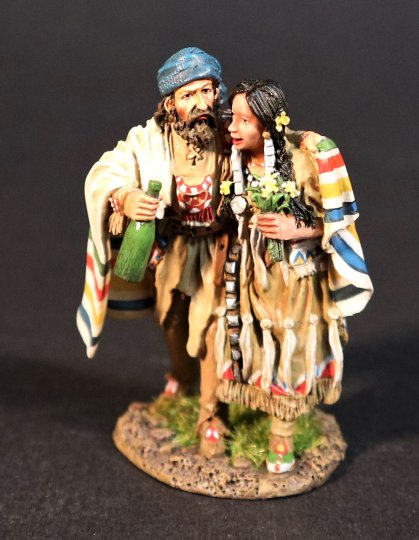- Joined
- Feb 2, 2011
- Messages
- 2,093
NEW RELEASES FOR JUNE 2022
THE FUR TRADE
A mountain man was an explorer who lived in the wilderness. They were instrumental in opening up the various Emigrant Trails (widened into wagon roads) allowing Americans in the east to settle the new territories of the far west by organized wagon trains traveling over roads explored and in many cases, physically improved by the mountain men and the big fur companies originally to serve the mule train based inland fur trade.
Mountain men were most common in the North American Rocky Mountains from about 1810 through to the 1880s (with a peak population in the early 1840s). Approximately 3,000 mountain men ranged the mountains between 1820 and 1840, the peak beaver-harvesting period. While there were many free trappers, most mountain men were employed by major fur companies. The life of a company man was almost militarized. The men had mess groups, hunted and trapped in brigades and always reported to the head of the trapping party.
This man was called a "boosway", a bastardization of the French term bourgeois. He was the leader of the brigade and the head trader.
The Mountain men represents the “Beaver Pelts” of the original WSP title, and is the smallest part of the series, as it mainly concentrates on the individual men and personalities that worked alone or in pairs in the mountain wilderness.

WSP-53
THE FUR TRADE,
THE ROCKY MOUNTAIN RENDEZVOUS,
THE TRAPPERS.
(1 pc)
Trappers lived lonely lives in the wilderness, and often took Indian wives. The trapper would trade with the father. The maidens it was said were not averse to a white man as a husband, for as a mountain man’s wife they lived an easier life and received more gifts of finery.
The trapper in addition to acquiring a companion in the wilderness, got someone to care for his lodge, cook his meals, tan and help care for the hides, and make his buckskin clothing and moccasins. The ceremony was a simple one. Once the trapper had supplied enough goods to satisfy the father, the trapper and his bride walked off together wrapped in a blanket or buffalo robe to set up housekeeping on their own.
This custom was much the same with most of the Indian tribes of the plains.
THE FUR TRADE
A mountain man was an explorer who lived in the wilderness. They were instrumental in opening up the various Emigrant Trails (widened into wagon roads) allowing Americans in the east to settle the new territories of the far west by organized wagon trains traveling over roads explored and in many cases, physically improved by the mountain men and the big fur companies originally to serve the mule train based inland fur trade.
Mountain men were most common in the North American Rocky Mountains from about 1810 through to the 1880s (with a peak population in the early 1840s). Approximately 3,000 mountain men ranged the mountains between 1820 and 1840, the peak beaver-harvesting period. While there were many free trappers, most mountain men were employed by major fur companies. The life of a company man was almost militarized. The men had mess groups, hunted and trapped in brigades and always reported to the head of the trapping party.
This man was called a "boosway", a bastardization of the French term bourgeois. He was the leader of the brigade and the head trader.
The Mountain men represents the “Beaver Pelts” of the original WSP title, and is the smallest part of the series, as it mainly concentrates on the individual men and personalities that worked alone or in pairs in the mountain wilderness.

WSP-53
THE FUR TRADE,
THE ROCKY MOUNTAIN RENDEZVOUS,
THE TRAPPERS.
(1 pc)
Trappers lived lonely lives in the wilderness, and often took Indian wives. The trapper would trade with the father. The maidens it was said were not averse to a white man as a husband, for as a mountain man’s wife they lived an easier life and received more gifts of finery.
The trapper in addition to acquiring a companion in the wilderness, got someone to care for his lodge, cook his meals, tan and help care for the hides, and make his buckskin clothing and moccasins. The ceremony was a simple one. Once the trapper had supplied enough goods to satisfy the father, the trapper and his bride walked off together wrapped in a blanket or buffalo robe to set up housekeeping on their own.
This custom was much the same with most of the Indian tribes of the plains.

